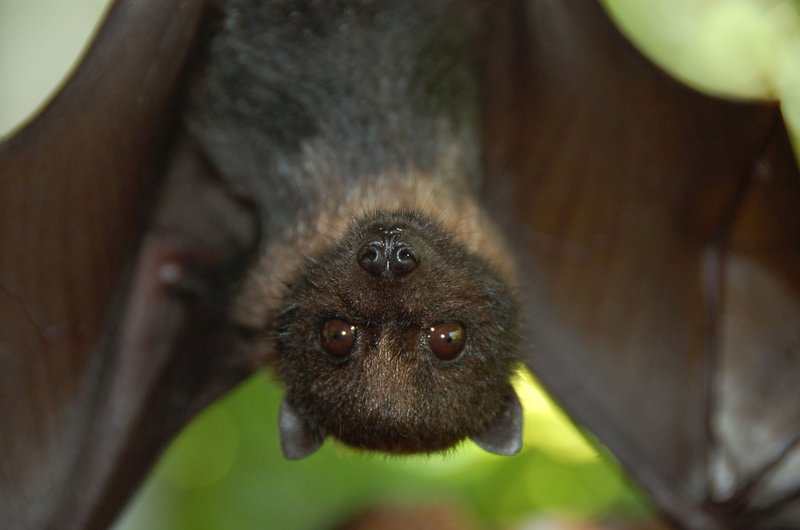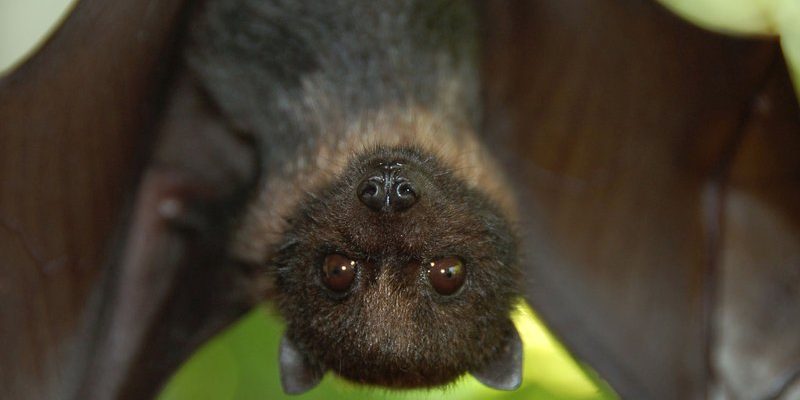
1. Common Vampire Bat
While they may not share the fruit bat’s diet of ripe bananas and juicy papayas, common vampire bats have a similar body structure. Both are part of the bat family, which means they share some physical traits, like wings and echolocation abilities.
What sets vampire bats apart is their diet. Instead of munching on fruit, these little critters are known for their blood-sucking habits. Generally found in Central and South America, they have sharp teeth and a specialized tongue that allows them to lap up blood from sleeping animals. You might be wondering how to differentiate them. Check for the sleek, more pointed wings of vampire bats compared to the broader wings of fruit bats.
2. Flying Squirrel
When it comes to gliders rather than flyers, the flying squirrel is a captivating comparison. These adorable little creatures may not have wings, but they do have a special flap of skin called the patagium that stretches from their wrists to their ankles. This allows them to glide gracefully from tree to tree, much like fruit bats soar through the night sky.
What’s cool about flying squirrels is their nocturnal habits and their diet, which can include fruits and nuts, similar to fruit bats. However, unlike bats, they are primarily rodents. If you see a furry face peeking from behind a tree trunk, you’re likely looking at a flying squirrel rather than a fruit bat!
3. Sugar Glider
Sugar gliders are tiny marsupials that live in Australia and New Guinea. Like flying squirrels, these creatures can glide through the air thanks to their patagium. At first glance, you might mistake them for smaller versions of a fruit bat, especially with their big eyes and furry bodies.
While fruit bats rely on echolocation to navigate, sugar gliders use their keen eyesight and sense of smell. Their diet includes fruits, but they also love sweet tree sap. If you come across something that looks like a mini fruit bat feasting on fruit at night, it could very well be a sugar glider!
4. Spix’s Macaw
You might not think of a macaw when discussing flying mammals, but the colorful Spix’s macaw has some similarities to fruit bats in terms of habitat and lifestyle. Both species thrive in the canopy of tropical rainforests, where they enjoy the lush fruits around them.
What really distinguishes Spix’s macaw from fruit bats is their social behavior. While fruit bats often roost in colonies, these birds typically live in small family groups. Keep an eye out for the vibrant blue feathers and the distinctive hooked beak if you’re trying to tell them apart!
5. Red Fox
While a red fox is much different in appearance, they share the fruit bat’s love for fruit and insects. You might spot a fox rummaging through a garden, feasting on berries or other fruits. Unlike fruit bats, foxes are terrestrial and have a bushy tail that they use for balance and communication.
The real difference, though, lies in their lifestyle. Foxes are primarily active during dusk and dawn, while fruit bats prefer the night for their foraging. If you see a furry critter with a keen sense of smell investigating its surroundings, it’s likely a red fox on the hunt for a snack, not a fruit bat soaring overhead.
6. Hoary Bat
The hoary bat is another member of the bat family, but it’s more closely related to the typical bats you might see in your backyard. These bats have thick fur and a distinctive yellowish-brown color that helps them blend into tree bark during the day.
Hoary bats can be found in North and South America, often foraging for insects rather than fruit. Their wing structure is similar to that of fruit bats, but they tend to have a more rounded shape, which can help you differentiate them. When spotting a hoary bat, listen for the rustling sound of wings amidst the trees at night!
7. Eastern Red Bat
Similar to the hoary bat, the eastern red bat finds its home in North America. With its bright reddish-brown fur, this bat resembles foliage or tree bark, making it easier for them to hide during the day.
Eastern red bats are also insectivores, unlike fruit bats, which focus on a fruit-based diet. But here’s the twist: these bats do hang upside down, just like fruit bats when they rest. To tell them apart, focus on their physical appearance—eastern red bats have a more compact body compared to the larger fruit bats.
8. Lesser Horsehoe Bat
The lesser horseshoe bat is a small bat that shares some features with the fruit bat. It has a rounded body and relatively short wings. You might also notice that these bats have a unique nose structure—much different from fruit bats. Their diet mainly consists of insects, specifically moths.
What’s interesting is the way they roost. Lesser horseshoe bats prefer to hide in small crevices or under leaves, while fruit bats tend to hang out in larger colonies. If you spot a tiny bat clinging quietly to a tree or rock face, you might just be lucky enough to see one of these lesser horseshoe bats!
9. Common Pipistrelle Bat
The common pipistrelle bat is one of the most familiar bat species in Europe. Characterized by its small size and swift flying capabilities, it’s often seen darting through the air. Unlike fruit bats, pipistrelles have a more insectivorous diet, but they do share the night sky with their fruit-eating cousins.
With a wingspan that’s considerably smaller than that of the fruit bat, common pipistrelles are agile flyers, ideal for catching insects in mid-air. You can identify them by their spotted fur and the tiny, pointed wings. If you hear a flurry of wings buzzing nearby, it could likely be a pipistrelle, not our fruit bat friends.
10. Spectacled Flying Fox
Lastly, let’s circle back to another bat—the spectacled flying fox. Found primarily in Australia and nearby islands, this bat’s appearance is strikingly similar to the fruit bat. In fact, they’re closely related!
One of the easiest ways to tell them apart is by their size. Spectacled flying foxes are larger and have distinctive white markings around their eyes, resembling spectacles. They also prefer a diet of fruit, just like their fruit bat counterparts. Spotting these large bats munching on mangos in the treetops is a sight you won’t soon forget!
Wrapping it Up
Exploring the world of animals similar to the fruit bat reveals a fascinating variety of species. From the agile flying squirrel to the colorful Spix’s macaw, each of these creatures brings something unique to the table. Understanding how to tell them apart not only enhances your wildlife knowledge but also deepens your appreciation for the incredible diversity in nature.
So, next time you find yourself in a botanical garden or a lush forest, keep your eyes peeled and your curiosity alive. Who knows what creatures you might spot flitting through the trees!

